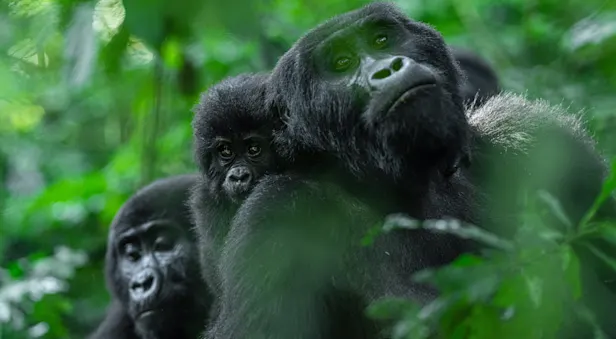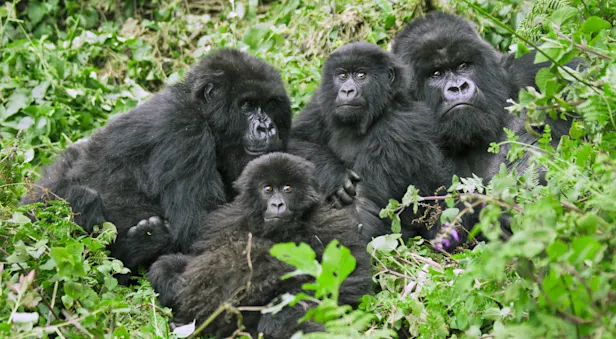Baboon Facts | Uganda & Rwanda Wildlife Guide
Baboons belong to the genus Papio, which can be divided into five species. The yellow baboon is distributed throughout East and Southern Africa. Baboons range in size and weight depending on species, the largest being the chacma baboon, found in Southern Africa, which can weigh as much as 88 pounds. The yellow baboon bears resemblance to the chacma baboon, though it is of slighter build and has a shorter muzzle. The most wide-ranging species is the olive baboon, and this is the most common species found in Uganda and Rwanda. It has a long coat that appears gray-green from afar and a dog-like muzzle.
Physical Characteristics
Highly sexually dimorphic. Males can weigh twice as much as females.
Elongated muzzles, broad, strong jaws with fang-like canines, thick fur (excluding the muzzle), close-set eyes and stocky tails.
Ischial callosities are pads of skin on their protruding rumps that are used to sit comfortably.
Habitat
Baboons dwell on the ground, and live in open African savannas, woodlands and hills. Olive baboons in Uganda and Rwanda can be found in dense tropical forests.
Behavior
Members of baboon troops are closely knit, and they forage, travel and sleep together. Home ranges between three and 13 miles have been reported. The daily range of a troop varies between three and eight miles. A troop’s movement can vary according to the availability of sleeping and watering sites. They sleep on cliffs and rocks, so daily life must allow for a sleeping site to be accessible by nightfall.
Factors determining rank are often hard to identify, but for many baboons, kinship is evidently important. In these species, females associate closely with other members of the same matriline within their troop and support them in contests with members of other kin groups.
A female’s rank depends on the matriline to which she belongs: all members of high-ranking matrilines out-rank all members of low-ranking ones, irrespective of age. Dominance relationships between females belonging to the same matriline are also consistent, and in baboons, have proved to be inversely related to priority in the order of birth.
Closely related adult females often cooperate in other ways. They will share feeding and sleeping sites and care for each other’s offspring. However, cooperative relationships are not restricted to relatives.
Breeding
Reproductive behavior is closely tied to social organization. Most baboons live in groups between 20 and 50 members, usually consisting of multi-male troops with several breeding males and a larger number of females. It was once thought that the presence of several males in a troop served to protect females and juveniles from attack by predators, but there is little evidence that this is the case. The most likely explanation for the occurrence of multi-male troops is that they occur where female groups are too large or too widely dispersed for it to be feasible for a dominant male to evict other males.
In groups with both many males and females, it is possible for any male to choose any female as his mate. Thus, this sparks great competition between males for a female’s attention. There are other components to consider when evaluating a male’s mating success as well. These include forming alliances with other males and forming “friendships” with females in which the males share their food, groom and have strong affiliative bonds with certain females and their young, thus increasing their chances of mating.
Gestation generally lasts six months, and baboon females typically give birth to one newborn. The infants are black in color, their coats turning lighter as they age. The infant relies solely on its mother for the first months of life, until it can eat solid food and is able to walk. Female baboons perform most parental duties, grooming, nursing and playing with their young.
Infants are weaned after about a year. Adolescents become sexually mature anytime between 5 to 8 years old. Females stay in the same troop their entire lives, while males will depart, often before reaching sexual maturity. Baboons in the wild live until about age 30, though in captivity have reached age 45.
Feeding Habits
Baboons have an omnivorous diet but are, for the most part, herbivorous. They do, however, eat insects, and will on occasion eat shellfish, trout, salmon and birds, in addition to small antelope and vervet monkeys. They are even known to steal goats and sheep from human homesteads. Baboons forage at intermittent periods during daylight and nighttime hours. Baboons are able to survive in arid environments, such as grasslands, steppes and deserts, due to their ability to subsist on grass alone for long periods of time.
Olive baboons have a broad diet and eat grasses, roots, lichen, pods, fruits, seeds, tubers, bark, mushrooms, leaves, buds, flowers, insects and small prey. They even hunt other primates, such as vervet monkeys.
Predation
Baboons’ primary predators are humans, spotted and striped hyenas, lions, cheetahs, leopards and crocodiles. Leopards find them to be difficult prey, so only young baboons are threatened in most cases.

































